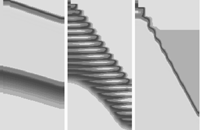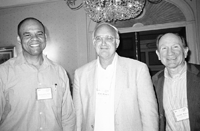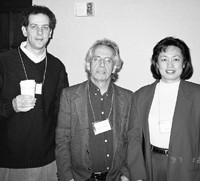New Starts for SIAM in its 50th Year
April 3, 2002

Bard Ermentrout, an invited speaker at the First SIAM Conference on Life Sciences, discussed spatiotemporal pattern formation in neuronal networks. Shown here from his talk are three simulations of a network of 100 coupled neurons, with delayed excitation (space is horizontal, time vertical). On the left is a pulse propagating with small or no delays. A delay (middle) results in "lurching waves"---small groups of neurons fire together, with temporal gaps between the groups. As shown on the right, the delay can destabilize pulses, but not wavefronts.
Talk of the Society
Thomas Manteuffel and James Crowley
Despite a six-month delay, the back-to-back SIAM conferences on imaging sciences and life sciences, held in Boston the week of March 4-8, were a great success. Originally planned for the third week in September, these conferences were postponed and hurriedly rescheduled.
These were the first meetings for SIAM's newest activity groups, and each attracted well over two hundred participants (230 for imaging and 295 for life sciences) and a full complement of invited, minisymposium, and contributed and poster presentations. Of particular note is that many of the participants were from academic departments and companies not traditionally associated with SIAM.

David Wilson (right), chair of the organizing committee for the First SIAM Conference on Imaging Science, with Bernard Mair (left), also a member of the committee, and Harry Barrett.
A quick glance at the program reveals speakers from departments of medical imaging, radiology, and even psychology at the imaging meeting. The life sciences organizers provided an equally diverse program, drawing on departments of neurology, neurosurgery, ecology, and environmental science, along with a long list of "bio" disciplines: biomedicine, bioengineering, biomathematics, biophysics, biodynamics, bioinformatics. . . .
Having just returned from Boston as this issue of SIAM News heads to press, we thought to share a few impressions with you. I (TM) took the opportunity to browse, attending talks on a wide selection of topics. Invariably, I encountered young, dynamic speakers who were eager to share their applications and their ideas. The talks were often followed by lively discussion. The meeting gave me the opportunity to learn about new applications and new ideas.
For example, I enjoyed the talks on variational methods in imaging, an application of techniques with which I am familiar in a very different setting. Also interesting were the talks on the identification of protein structure from known sequences, a powerful application of pattern recognition methods. Complicated mathematical models were described in contexts ranging from brain mapping to neural behavior to epidemiology. It was clear that mathematics has had a profound impact on these areas and that there are abundant opportunities for even greater impact.
The decision to establish activity groups in areas that stretch the boundaries of SIAM's traditional interests will inevitably cause change. We hope that the groups in imaging and life sciences, along with the recently formed SIAM Activity Group on Computational Science and Engineering, will attract new members to SIAM. Many of these new members will most likely have training and interests different from those of the current SIAM membership. I believe that this will be a healthy change. It will also be a challenge for SIAM to accommodate the needs of these new members.
As the Boston meetings were unfolding, Marty Golubitsky and Margaret Wright spent a day at the SIAM office in Philadelphia. Following many months of energetic efforts, they were organizing the gratifyingly large numbers of papers submitted for presentation at the SIAM 50th Anniversary and 2002 Annual Meeting into a scheduled program of coherent sessions. Based on the large numbers of both minisymposium and contributed talks, we expect good attendance at the meeting, which will be held in Philadelphia (SIAM's birthplace, as well as our current home), July 8-12. Of course, we hope that as many of you as possible will join us for this celebration.

Nonlinear PDEs in imaging-one of the main conference themes-surfaced in the talks of Guillermo Sapiro (left), on techniques for inpainting, and invited speaker Stan Osher (middle), who described successful applications of various PDE-based methods, including shock-capturing algorithms and the level set method, in information technology. With them is Wen Masters of the Office of Naval Research, whose remarks in a panel discussion of current Department of Defense interests focused on applied analysis in imaging.
And a celebration it will be! In addition to the technical program, we're planning some special events, among them a gala dinner on Thursday, July 11, to which all members are invited. This will be a special chance for all of us to meet with old friends and celebrate this festive occasion. It is a subscription event (with the cost to be partially subsidized by SIAM), so please let us know when you register for the meeting if you wish to attend.
An outstanding technical program is taking shape, thanks to Margaret, Marty, and the other members of the organizing committee---Marsha Berger, Heinz Engl, and Walter Strauss. See www.siam.org for program updates.
We're extremely happy to report two recent additions to the list of speakers: Eric Lander of the Whitehead Institute, who will give the 2002 John von Neumann Lecture, and Rita Colwell, director of the National Science Foundation.
As always, we hope to see many students at the Philadelphia meeting. One way we encourage students to participate in SIAM activities is through the Student Travel Fund. A student wishing to attend a SIAM conference can apply for a grant from the fund; selected students receive up to $500 to defray their travel expenses, as well as free registration for the conference. Approximately 40 students benefit from the fund each year, attending SIAM conferences that might otherwise have been out of reach.
The Student Travel Fund was started in 1991 by a group of generous SIAM book authors who volunteered to donate their royalties to the fund. Many additional authors subsequently joined in; to date, authors have contributed a total of more than $85,000 to the fund, which has been supplemented by contributions from SIAM and from other donors. Most recently, a request for donations on the 2002 membership renewal form generated more than $7000 for the fund.
We would like to take this opportunity to thank all who have contributed to the Student Travel Fund---both our many generous authors* and the SIAM members who opted to make donations with their renewals.
*Natalia Alexandrov, E. Anderson, Greg Astfalk, Zhaojun Bai, David Bailey, Venkataramanan Balakrish-nan, Richard Barrett, Michael Berry, Christian Bischof, Petter Bj�rstaad, L.S. Blackford, S. Blackford, Stephen Boyd, Tony Chan, J. Choi, A. Cleary, E. D'Azevedo, James Demmel, John Dennis, Inderjit Dhillon, June Donato, Jack Dongarra, Jeremy Du Croz, Iain Duff, Laurent El Ghaoui, Victor Eijkhout, Eric Feron, John Gilbert, Anne Greenbaum, Sven Hammarling, G. Henry, M.Y. Hussaini, Ken Kennedy, David Keyes, Chuck Koelbel, John Lagnese, Cornelius Lanczos, Richard Lehoucq, Michael Leuze, John Lewis, Michael Mascagni, A. McKenney, Paul Messina, Beres-ford Parlett, A. Petitet, Linda Petzold, Roldan Pozo, Daniel Reed, Charles Romine, Axel Ruhe, Youcef Saad, Robert Schnabel, Robert Schreiber, Horst Simon, Richard Sincovec, Danny C. Sorensen, G.W. Stewart, K. Stanley, Virginia Torczon, Bernard Tourancheau, Donald Truhlar, Henk van der Vorst, Robert Voigt, D. Walker, Layne Watson, R.C. Whaley, and C.Yang.

